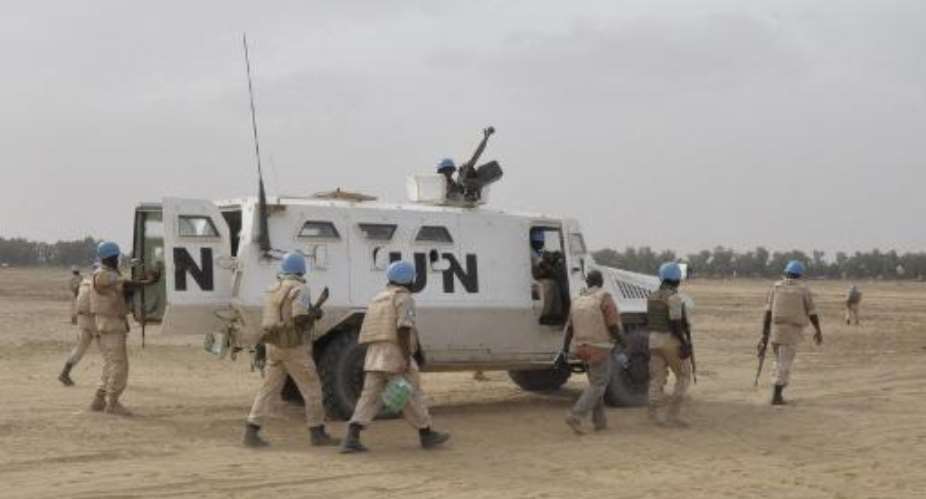Bamako (AFP) - Northern Mali is a vast desert region controlled by a patchwork of armed groups loyal to the government or opposed to it, with differing goals and subject to unstable alliances.
In late 2012 the area was dominated by jihadist militants linked to Al-Qaeda who routed Malian army troops with help from Tuareg rebels, before shunting the Tuaregs aside.
An international military campaign then pushed the Islamists from many areas but the Malian government still does not control much of its northern territory. The Tuareg are a non-Arab, nomadic people.
Here is a quick look at the principle groups in northern Mali.
Rebels
- The Coordination of Azawad Movements (CMA)
The Tuareg-led CMA, which spurned a ceremonial signing on Friday of a peace accord with the government, comprises the main rebel groups. It is led by Bilal Ag Cherif.
The CMA initialled the peace agreement but then demanded formal recognition of "Azawad", the Tuareg name for northern Mali, as a "geographic, political and legal entity." The Coordination also wants local security forces to comprise 80 percent of Azawad inhabitants.
It consists of three main groups.
- The National Movement for the Liberation of Azawad, (MNLA)
One of the strongest armed groups in northern Mali, the MNLA is a Tuareg-dominated political and military movement created via the fusion of various rebel units in October 2011. Initially independentist, it now seeks greater autonomy for Azawad, which it considers the cradle of Tuareg populations.
The MNLA joined the January 2012 offensive against government troops with groups close to Al-Qaeda, but was then sidelined. A year later, MNLA units appeared in Kidal, northeastern Mali, following a French-led intervention against the jihadist militants.
- The High Council for the Unity of Azawad (HCUA)
The HCUA was created in May 2013, mainly by dissident elements of Ansar Dine (Defenders of Faith), a jihadist group that occupied parts of northern Mali in 2012 before being driven out by international forces. It is based in Kidal and most of its fighters are Tuareg from the Ifoghas tribe.
- Arab Movement of Azawad (MAA)
The MAA was created in March 2012 and is comprised mainly of Arab militia fighters. The movement was weakened in 2013-2014 by a split between factions that allied themselves with the MNLA and HCUA on one hand, and another that decided to back the Malian government.
Other entities that make up the CMA are the Coalition for the People of Azawad (CPA), a Tuareg-dominated movement created in March 2014 by a former MNLA cadre, and self-defence units comprised of settled populations in the region.
Pro-government groups
- The Imghad and Allies Tuareg Self-Defence Group (GATIA) was created in August 2014 by Tuareg in the north "to defend the interests of our community, notably against the MNLA" according to its chief, Fahad Ag Almahmoud.
The group, which claims to "recognise the territorial integrity of Mali and is not demanding autonomy" is the mainstay of pro-governmental factions, and in April it took control of Menaka, a town in eastern Mali that had been partially controlled by rebels.
- The Coordination of Movements and Patriotic Resistance Fronts (CM-FPR) groups numerous self-defence organisations, and is mainly made up of members of sub-Saharan African populations.





 We’ll protect state wealth from opaque deals – Prof Jane Naana
We’ll protect state wealth from opaque deals – Prof Jane Naana
 Mauritania president says running for second term in June polls
Mauritania president says running for second term in June polls
 I won't ever say I was a mere driver’s mate' — Prof. Opoku-Agyemang
I won't ever say I was a mere driver’s mate' — Prof. Opoku-Agyemang
 2024 polls: 'EC struggling to defend credibility'— Prof. Opoku-Agyemang
2024 polls: 'EC struggling to defend credibility'— Prof. Opoku-Agyemang
 Akufo-Addo gov't's 'greed, unbridled arrogance, unrestrained impunity, sheer dis...
Akufo-Addo gov't's 'greed, unbridled arrogance, unrestrained impunity, sheer dis...
 Election 2024: Ghana needs an urgent reset, a leadership that is inspiring – Ma...
Election 2024: Ghana needs an urgent reset, a leadership that is inspiring – Ma...
 Partner NDC to rollout a future of limitless prospects – Prof Jane Naana Opoku-A...
Partner NDC to rollout a future of limitless prospects – Prof Jane Naana Opoku-A...
 NPP will remain in gov’t till Jesus comes — Diana Asamoah
NPP will remain in gov’t till Jesus comes — Diana Asamoah
 Sunyani Technical University demands apology from former SRC president over sex-...
Sunyani Technical University demands apology from former SRC president over sex-...
 'Dumsor' was resolved by Mahama but ‘incompetent' Akufo-Addo has destroyed the g...
'Dumsor' was resolved by Mahama but ‘incompetent' Akufo-Addo has destroyed the g...
